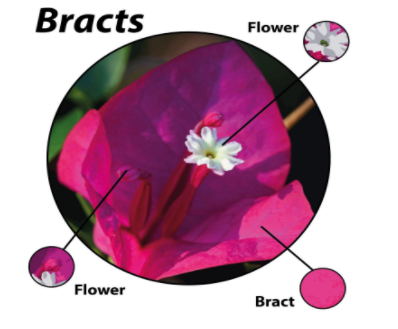
The color of the Bougainvillea flower is due to the color of its
(a) Corolla
(b) Bracts
(c) Calyx
(d) Androecium
Answer
575.1k+ views
Hint: They are the modification of the leaves that may be responsible for the formation of flowers, scales, cones, or inflorescence having different shapes, sizes, and colors and may even form sepals or petals of the flower.
Complete Step by Step Solution:
The color of the Bougainvillea flower depends upon the color of its bracts. These bracts are the specialized leaf that is modified. They may even form the petals or sepals of the flowers giving them different colors.
- Bracts are having variation in their shape, size, and colors with the variable texture may be smaller or larger in size.
- Although bracts may constitute sepals and petals they are quite different from them.
- When the flowers constitute of bracts then they are called bracteate or bracteolate while the state of the plant that lacks brackets is called bracteate and bracteolate.
- These bracts perform various functions depending upon their shape, size, and color.
- When the bracts are brightly colored then their primary function is to attract insects for the process of pollination.

- In the case of Bougainville, the bracts are larger and colorful while the flowers have smaller and less colorful petals. The bracts are sepal- like, large, and colorful and cover the three flowers that are waxy and simple.
- In the case of grasses, various types of bracts are present that help the grains in covering and protection.
So, the correct answer is ‘(b) Bracts’.
Note: Bracts are of various types depending upon their functions, they include involucral bracts (they form an inflorescence called involucre when they are arranged in a whorl), epicalyx (the presence of extra whorl of bracts around the calyx of a flower), and spathe (a pair of large bracts that appear as a sheet around the flowers of palms, arums,e ct to attract insects for pollination).
Complete Step by Step Solution:
The color of the Bougainvillea flower depends upon the color of its bracts. These bracts are the specialized leaf that is modified. They may even form the petals or sepals of the flowers giving them different colors.
- Bracts are having variation in their shape, size, and colors with the variable texture may be smaller or larger in size.
- Although bracts may constitute sepals and petals they are quite different from them.
- When the flowers constitute of bracts then they are called bracteate or bracteolate while the state of the plant that lacks brackets is called bracteate and bracteolate.
- These bracts perform various functions depending upon their shape, size, and color.
- When the bracts are brightly colored then their primary function is to attract insects for the process of pollination.

- In the case of Bougainville, the bracts are larger and colorful while the flowers have smaller and less colorful petals. The bracts are sepal- like, large, and colorful and cover the three flowers that are waxy and simple.
- In the case of grasses, various types of bracts are present that help the grains in covering and protection.
So, the correct answer is ‘(b) Bracts’.
Note: Bracts are of various types depending upon their functions, they include involucral bracts (they form an inflorescence called involucre when they are arranged in a whorl), epicalyx (the presence of extra whorl of bracts around the calyx of a flower), and spathe (a pair of large bracts that appear as a sheet around the flowers of palms, arums,e ct to attract insects for pollination).
Recently Updated Pages
Master Class 11 Business Studies: Engaging Questions & Answers for Success

Master Class 11 English: Engaging Questions & Answers for Success

Master Class 11 Computer Science: Engaging Questions & Answers for Success

Master Class 11 Social Science: Engaging Questions & Answers for Success

Master Class 11 Maths: Engaging Questions & Answers for Success

Master Class 11 Biology: Engaging Questions & Answers for Success

Trending doubts
Differentiate between an exothermic and an endothermic class 11 chemistry CBSE

One Metric ton is equal to kg A 10000 B 1000 C 100 class 11 physics CBSE

Explain zero factorial class 11 maths CBSE

State the laws of reflection of light

What is 1s 2s 2p 3s 3p class 11 chemistry CBSE

Difference Between Prokaryotic Cells and Eukaryotic Cells




